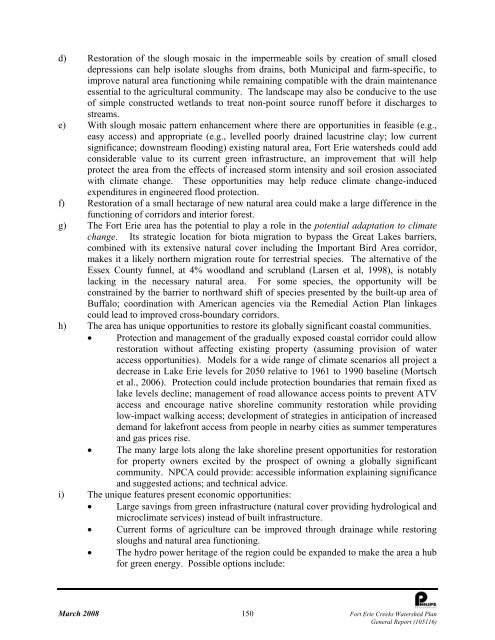Fort Erie Creeks Watershed Plan - Niagara Peninsula Conservation ...
Fort Erie Creeks Watershed Plan - Niagara Peninsula Conservation ...
Fort Erie Creeks Watershed Plan - Niagara Peninsula Conservation ...
Create successful ePaper yourself
Turn your PDF publications into a flip-book with our unique Google optimized e-Paper software.
d) Restoration of the slough mosaic in the impermeable soils by creation of small closed<br />
depressions can help isolate sloughs from drains, both Municipal and farm-specific, to<br />
improve natural area functioning while remaining compatible with the drain maintenance<br />
essential to the agricultural community. The landscape may also be conducive to the use<br />
of simple constructed wetlands to treat non-point source runoff before it discharges to<br />
streams.<br />
e) With slough mosaic pattern enhancement where there are opportunities in feasible (e.g.,<br />
easy access) and appropriate (e.g., levelled poorly drained lacustrine clay; low current<br />
significance; downstream flooding) existing natural area, <strong>Fort</strong> <strong>Erie</strong> watersheds could add<br />
considerable value to its current green infrastructure, an improvement that will help<br />
protect the area from the effects of increased storm intensity and soil erosion associated<br />
with climate change. These opportunities may help reduce climate change-induced<br />
expenditures in engineered flood protection.<br />
f) Restoration of a small hectarage of new natural area could make a large difference in the<br />
functioning of corridors and interior forest.<br />
g) The <strong>Fort</strong> <strong>Erie</strong> area has the potential to play a role in the potential adaptation to climate<br />
change. Its strategic location for biota migration to bypass the Great Lakes barriers,<br />
combined with its extensive natural cover including the Important Bird Area corridor,<br />
makes it a likely northern migration route for terrestrial species. The alternative of the<br />
Essex County funnel, at 4% woodland and scrubland (Larsen et al, 1998), is notably<br />
lacking in the necessary natural area. For some species, the opportunity will be<br />
constrained by the barrier to northward shift of species presented by the built-up area of<br />
Buffalo; coordination with American agencies via the Remedial Action <strong>Plan</strong> linkages<br />
could lead to improved cross-boundary corridors.<br />
h) The area has unique opportunities to restore its globally significant coastal communities.<br />
• Protection and management of the gradually exposed coastal corridor could allow<br />
restoration without affecting existing property (assuming provision of water<br />
access opportunities). Models for a wide range of climate scenarios all project a<br />
decrease in Lake <strong>Erie</strong> levels for 2050 relative to 1961 to 1990 baseline (Mortsch<br />
et al., 2006). Protection could include protection boundaries that remain fixed as<br />
lake levels decline; management of road allowance access points to prevent ATV<br />
access and encourage native shoreline community restoration while providing<br />
low-impact walking access; development of strategies in anticipation of increased<br />
demand for lakefront access from people in nearby cities as summer temperatures<br />
and gas prices rise.<br />
• The many large lots along the lake shoreline present opportunities for restoration<br />
for property owners excited by the prospect of owning a globally significant<br />
community. NPCA could provide: accessible information explaining significance<br />
and suggested actions; and technical advice.<br />
i) The unique features present economic opportunities:<br />
• Large savings from green infrastructure (natural cover providing hydrological and<br />
microclimate services) instead of built infrastructure.<br />
• Current forms of agriculture can be improved through drainage while restoring<br />
sloughs and natural area functioning.<br />
• The hydro power heritage of the region could be expanded to make the area a hub<br />
for green energy. Possible options include:<br />
March 2008 150 <strong>Fort</strong> <strong>Erie</strong> <strong>Creeks</strong> <strong>Watershed</strong> <strong>Plan</strong><br />
General Report (105116)
















